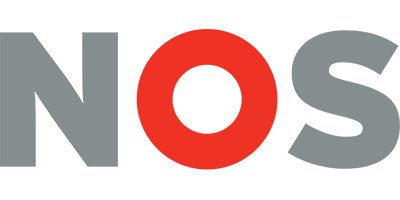
There are numerous methods to measure brain activity. In neuromarketing, two stand out: EEG and fMRI.
EEG (fully written as electroencephalogram) is known in the form of the 'swimming cap' or loose electrodes placed on the head. fMRI uses a large scanner, where the respondent lies flat in a long tunnel. Both methods have a long history in the medical world and have been applied in marketing since the new millennium.
While the very first neuromarketing studies were mainly based on fMRI, EEG is today the most used research method in neuromarketing (and neuroscientific research).
That EEG and fMRI are entirely different techniques is immediately clear. But what are the main differences between EEG and fMRI with regard to marketing? And how do these differences affect the insights and applications you can expect from these methodologies?
In this blog, we list the 5 crucial differences between EEG and fMRI in neuromarketing research.
Measurement: EEG measures electrical activity (directly). fMRI measures oxygen-rich blood (indirectly).
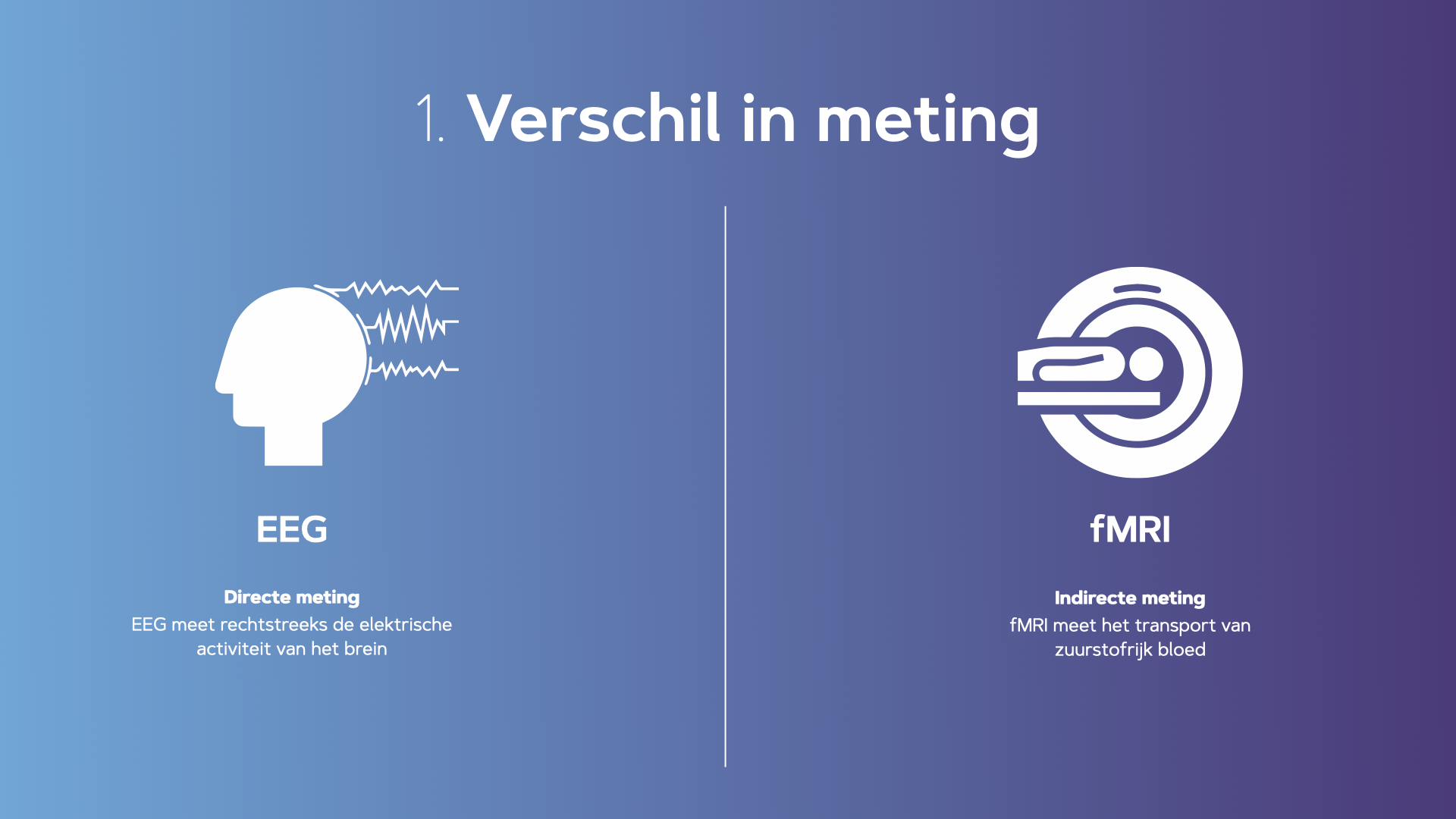
EEG is direct
Just like the device you are using to read this blog, your brain also works on electricity. When a neuron in your brain becomes active, electrical activity is released. An EEG measures this electrical activity via electrodes on the head. This measurement is direct. This means that EEG records brain activity at the exact moment it occurs.
fMRI is indirect
fMRI is a completely different technique to measure brain activity. When a specific part of the brain becomes active, oxygen-rich blood flows to this location. The MRI scanner takes a picture of the brain every few (3 to 5) seconds to measure the transport of this oxygen-rich blood. This makes research with fMRI indirect: the method does not measure direct brain activity (electrical signal) but focuses on the consequence of the activity (transport of oxygen-rich blood). fMRI thus does not measure brain activity but the physiological traces that this activity leaves behind.
Gratis Webinar: "Behavior Bootcamp Training: Sneak Peak"
In dit webinar maak je gratis kennis met de Behavior Bootcamp, de tweedaagse training in gedragsverandering van Unravel Behavior. Ontdek de unieke structuur, leer de drijfveren achter menselijk gedrag herkennen en krijg alvast invloedrijke technieken aangereikt om direct toe te passen.
Schrijf je nu gratis in voor deze lunch-webinar op Wednesday 23 April van 12.00 tot 12.45
Why is this difference important for neuromarketing?
The difference between the direct measurement of EEG and the indirect measurement of fMRI has significant implications for their applicability in neuromarketing. The direct EEG measurement tells you with millisecond precision what is happening in the brain. This makes EEG the most suitable candidate for dynamic stimuli, such as research into advertisements, online usability, and interaction with retail environments. Because fMRI is an indirect and therefore slower measurement, you cannot pinpoint the exact time the brain response occurred. For static stimuli, this is not a problem (images, packaging, prices) – these stimuli do not change. However, for the aforementioned dynamic stimuli, EEG is preferred due to the direct measurement.
In the next section, we delve deeper into the trade-off between EEG and fMRI in terms of speed and specificity.
Speed and Specificity: EEG is global and fast. fMRI is specific but slow.
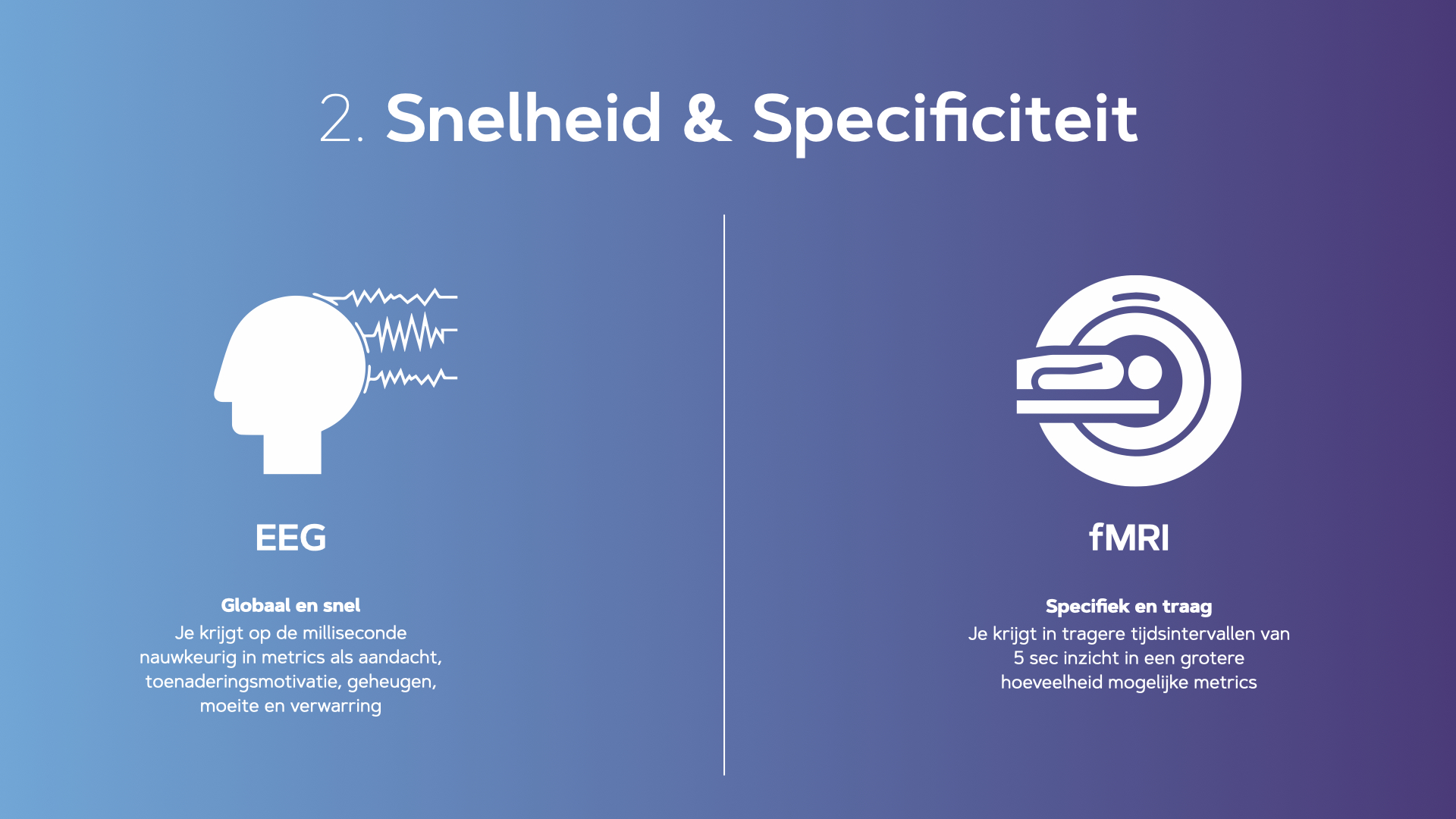
Although EEG is a fast and direct measurement, the electrodes are limited to the cortex of the brain. The result is that the typical EEG metrics focus on fundamental brain processes: attention, approach motivation, memory, effort, and confusion.
An fMRI measurement is considerably slower but measures the entire brain. This deeper dataset offers more points of reference for possible metrics. While EEG predicts the impact of a stimulus on purchasing behaviour through a total positive 'approach motivation' of the brain, fMRI can further break down this approach motivation into pleasure, trust, and interest (to name just a few possible labels). However, the question remains to what extent this accumulation of possible metrics is actually meaningful, and not just filling a report with intangible nuances that many marketers shrug off. Many marketers agree that a targeted selection of clear and meaningful metrics offers more valuable insight than a multitude of metrics that are difficult to distinguish from each other.
In short: the optimal method depends on your marketing question.
Suppose you want to conduct a neuromarketing study on your new advertising campaign. If you want to test to what extent the advertisement succeeds in positively influencing brand preference – and ultimately sales – both EEG and fMRI point you in the right direction. If you want to know exactly which moment of your advertisement underlies an emotional reaction, so you can further optimise the advertisement, only EEG provides the measurement speed to obtain this. If you want to measure the largest number of possible metrics – and you accept that you cannot trace the scores on these metrics back to specific moments in the advertisement – then fMRI is the optimal method.
However, to obtain an image of the brain with fMRI, high demands must be placed on the research environment and the respondent. We will discuss the realism and comfort of both research methods in the next section.
Realism & Comfort: EEG is comfortable and wireless. fMRI is bound to the MRI scanner.

The fMRI Setting
Undergoing an fMRI study is an experience you won't soon forget. The futuristic-looking MRI scanner is located in a clinical setting in the hospital. Because the scanner uses a strong magnetic field, you as a respondent must remove shoes, jewellery, and other metal objects to prevent dangerous situations. During the measurement, you lie in a narrow elongated tunnel and you must not move during the study (often averaging 1 hour). The machine produces a significant noise level, between 65 decibels (a vacuum cleaner) to 130 decibels (a rock concert). You wear headphones to properly receive the sound during audiovisual stimuli.
The above situation is a sore point for marketers, who strive for the most realistic setting possible in studies of their advertisements, products, websites, and stores. These concerns are not entirely justified, as an advertisement test in the more clinical fMRI setting also proves predictive of the commercial's success in the market. However, the question remains to what extent such a heavy research procedure is desirable and necessary when a more accessible and realistic method is available.
The EEG Setting
EEG, with its lightweight and (nowadays) wireless execution, forms a more realistic technique in neuromarketing. As a respondent in an EEG advertisement study, you do not have to lie flat in a long tunnel, but can watch TV reclining on the couch, with a drink of your choice – just like at home.
Correctly placing and calibrating an EEG headset for a pure signal takes 15 minutes. After that, the respondent is completely free and mobile; wearing EEG feels no different than wearing a cap.
This realism provides, in addition to a more pleasant experience for the respondent, a number of advantages that are inextricably linked to EEG research:
- EEG enables on-site research, such as in-store research and at the respondent's home
- EEG has a broader applicability in questions, such as usability research behind a computer or smartphone
- EEG allows more innovation through flexible deployment, such as the rise of Social Consumer Neuroscience, where the respondent does not view the stimulus independently in a lab but at home on the couch with friends or family
The differences between EEG and fMRI are decisive for the marketing questions they can and cannot answer.
Applicability: Which questions suit which method?
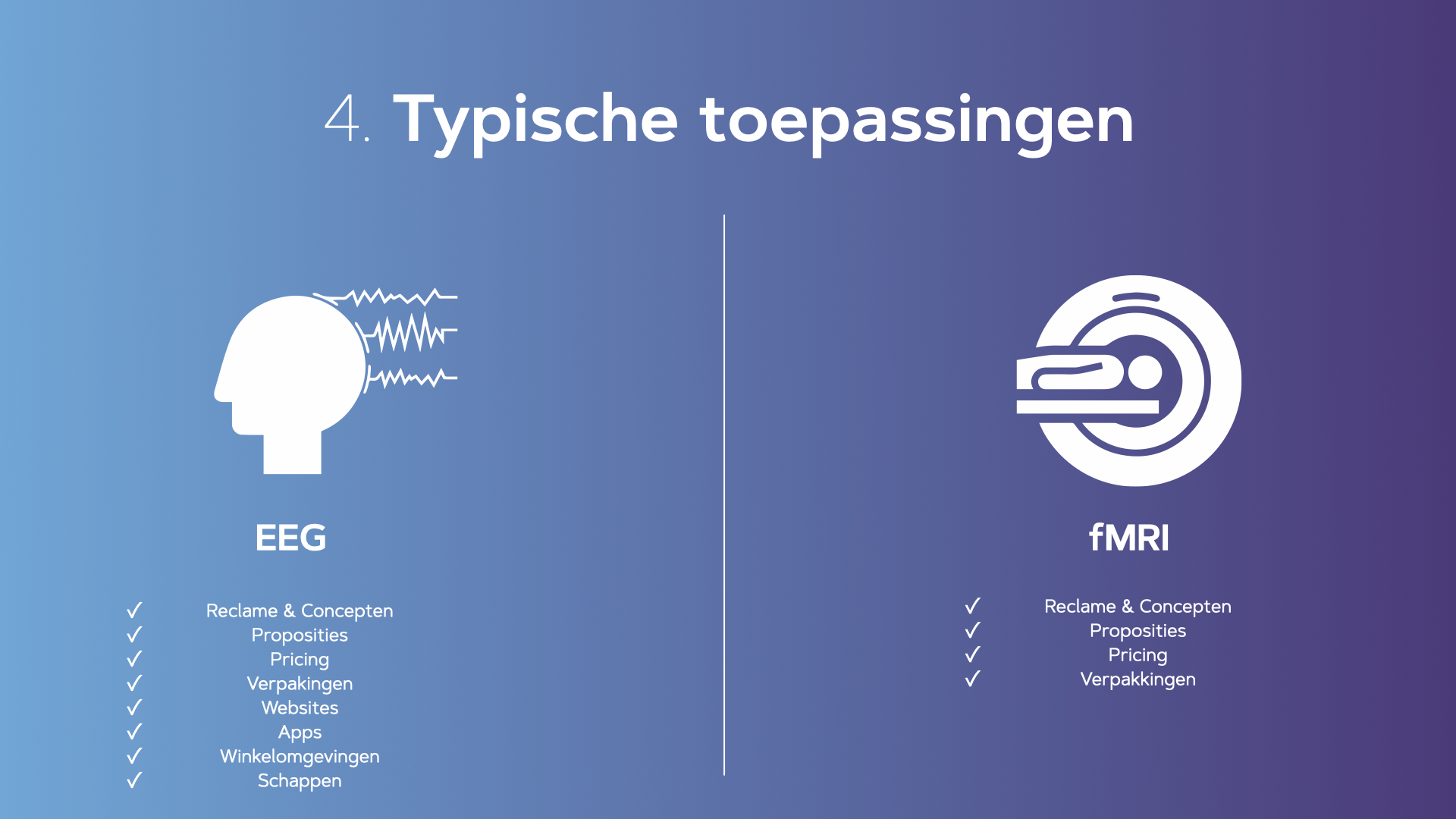
The basic setup of an EEG or fMRI study is the same: as a respondent, you interact with marketing stimuli while your brain activity is measured. The brain activity of a complete group of respondents ultimately says something about the impact and optimisation opportunities of the marketing stimulus.
But which marketing stimuli can be measured by each method?
fMRI
- Advertising & Concepts
- Propositions
- Pricing
- Packaging
EEG
The application area of EEG is broader than fMRI due to its flexibility. However, this does not mean that EEG is automatically the designated method for every question. Depending on the metrics and measurement speed that are important for the research question, the preference will go to EEG or fMRI (see section ‘Speed and Specificity’ in this blog).
Cost of Neuromarketing Research
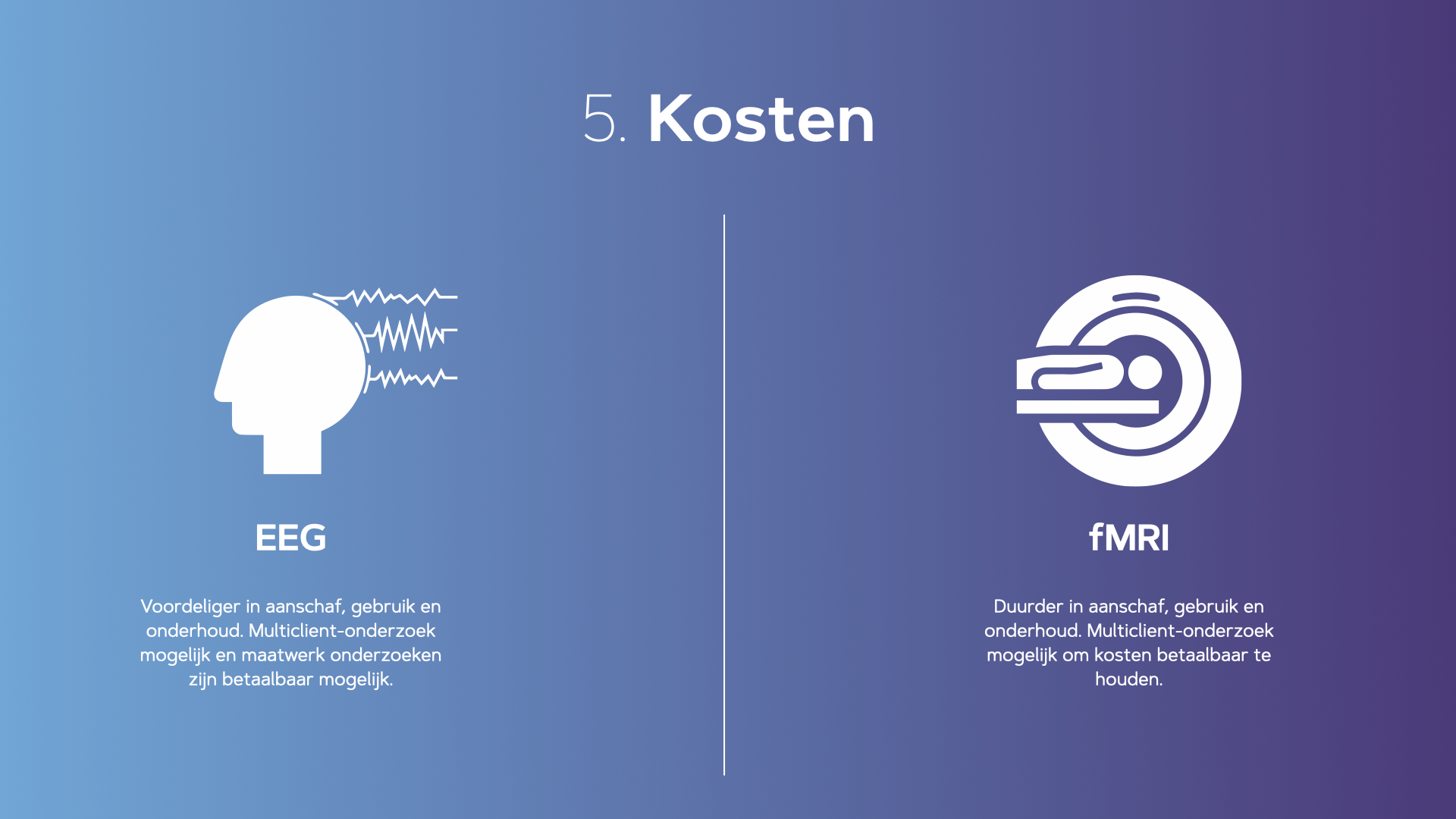
What does such a neuromarketing study cost? Not an unimportant question.
In most cases, the costs for an identical study with EEG are lower than with fMRI. This has several reasons:
- MRI scanner is more expensive to purchase, use, and maintain
- MRI scanner is often located in hospitals, which logically receive an additional fee for making their equipment and space available for market research
Although the starting price of a study is inevitably higher with fMRI than with EEG, research agencies specialised in fMRI (and EEG) offer multi-client studies for that reason. The costs are borne by multiple clients. However, this means you are subject to the planning, respondents, and limitations of the multi-client study. A custom study where you have 100% control over the planning, the number of stimuli to be tested, the respondents, and the method of administration is more advantageous with EEG.
Conclusion: EEG as the Standard in Neuromarketing Research
In this blog, we saw that EEG and fMRI each have their own advantages and disadvantages. Our conclusion is therefore pragmatic; research your question with the neuro-method that is able to realistically represent the necessary context and stimuli on the one hand, and is not hindered by the disadvantages inherent to the method.
This blog dissected the main criteria to determine whether EEG or fMRI best suits your research question. Let us not lose sight of the big picture. The great gain lies in the adoption of a neuroscientific method to measure what the consumer truly thinks, feels, and does. In other words: neuroscience as an alternative to traditional conscious methods such as surveys and interviews. Only then does the question become important as to which method forms the optimal compass through the brain.
EEG is used today in most neuromarketing studies due to its broader applicability, realistic research setting, and clear validated metrics. The authors of the paper 'Is EEG Suitable for Marketing Research? A Systematic Review' state: "In the past decade, marketing studies have greatly benefited from the adoption of neuroscience techniques to explore conscious and unconscious drivers of consumer behaviour. Electroencephalography (EEG) is one of the most frequently applied neuroscientific techniques for marketing studies, thanks to its low cost and high temporal resolution."
Image source fMRI: Mos.ru






